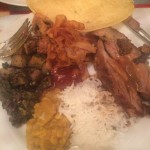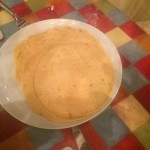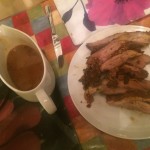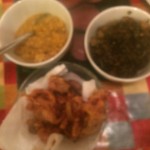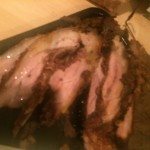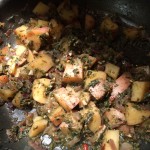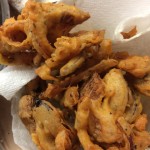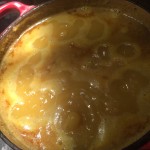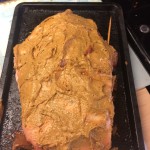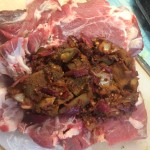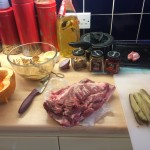This is not a unique meal, though this particular execution was entirely devised by me, for better or worse, and totally homemade into the bargain. What I’m especially proud of was how all the components came together out of the chaos to harmonise together on the plate at just the right time, that the lamb was perfectly medium-rare in spite of having had a extended cooking in the slow oven of the Aga, and that the aromatic coconutty gravy was spot on. So let’s address each of these in turn:
Roast lamb, stuffing and aromatic gravy
What to buy
Go to your butcher a day or two in advance and choose a nice healthy looking shoulder of lamb. A half shoulder should serve 3-4 with reasonable comfort, but for a bigger audience go the whole hog and get the full shoulder. Ask the butcher to bone the meat and give you back the bone. You can do this with a leg, but clearly it will cost a lot more and the fat in the shoulder should slowly render to give you an amazing flavour.
Lamb stock
Back home, roast the bones for a few minutes, then put in a large stock pan. Add sea salt, crushed black peppers, halved onion, celery sticks, roughly halved carrots, parsley stalks, thyme stems, bay leaves, garlic cloves and green veg (I used some broccoli stalks which were handy.) Add water, bring to the boil and simmer for 2-4 hours. Leave overnight, then drain into a large bowl, discarding the veg and bones. This being a straight stock, you can use any left over to make some lamb soup or any other dish.
Stuffing
Buy a small, firm and shiny aubergine. Pop it on a baking tray and into a preheated oven for 20-25 minutes. Use oven gloves to transfer to a chopping board, then cut off the stalk end. Using a sharp knife, peel off the skin, which should come fairly easily. Chop the aubergine into cubes.
Slice an onion finely and sauté lightly for a few minutes. Add the aubergine and coat in the hot oil. Add finely diced garlic and chilli without seeds, plus a half teaspoon each of fenugreek, cumin, paprika, cayenne and chopped fresh green coriander. Stir well in, then add a squirt of tomato paste and 2 tablespoons of balsamic vinegar – which adds both sweetness and piquancy.
Mix well and reduce slightly. The veg should hang together without having a lot of surplus liquid. Open out the lamb and add the stuffing mix, being careful not to have any drop out. Wrap tightly and secure with skewers. Place the lamb on an oven tin.
Crust
In a separate bowl, measure out 2-3 tablespoons of Greek yogurt. I used the version with honey, which works fine. To this add the following spices to taste:
- 1-2 teaspoons cumin
- 1-2 teaspoons coriander
- 1-2 teaspoons turmeric
- Black pepper
- Salt (I used black salt and chilli salt but rock or sea salt just as good)
- Half teaspoon cinnamon
- 1 teaspoon ginger
- Jaggery goor (palm sugar), grated
- Garlic paste
Mix well. Slash the lamb, not too deep. Coat the lamb thickly in the paste, cover with foil and allow to marinade for an hour at room temperature.
Gravy
Lightly sauté onions, add garlic, ginger, salt, pepper, turmeric, bay leaves, coriander stalks, crushed cardamom pods and desiccated coconut. Coat with oil then add the stock. Bring to the boil and reduce by half. Add a touch of sour cream and reduce for 2 mins. Sieve before serving.
Cooking
Having an Aga will be different to a conventional oven, but this is how I did it: 20 minutes in the hot oven to build up heat, then into the slow oven for 6 hours. I took the foil off for the last hour. Then I took the lamb out, allowed it to cool, and just before serving reheated it in the gravy.
Onion and mushroom bhajis
Red onions, gram flour, cornflour (roughly 80:20), ghee, lemon juice, cumin seeds, coriander seeds, fennel seeds, mustard seeds, black onion seeds, salt, pepper.
Mix flour, spices, ghee and juice with cold water to produce a thick batter. Add onions. Coat thoroughly. Deep fry at 180c until golden brown (typically 3-4 minutes.) Drain and serve with raita and mango chutney.
Veg and rice
On this occasion I served steamed basmati rice and Bombay potatoes, though you could serve with your own favourite Indian vegetable dishes. Bombay potatoes cooked as follows:
- Salt, to taste
- 3 large potatoes (around 900g in total), halved
- 15g root ginger, peeled weight
- 3 garlic cloves, peeled
- 2 large-ish tomatoes, one quartered,
the other cut into slim wedges - 4 tbsp vegetable oil
- ¾ tsp cumin seeds
- 1 tsp mustard seeds
- 1 large onion, roughly chopped
- 2/3 tsp turmeric
- 2 tsp ground coriander
- 1 tsp ground cumin
- 1 tsp garam masala
- ½–¾ tsp chilli powder
- Large handful of chopped coriander leaves
Bring a large pot of water to the boil and salt it well. Place in the potatoes and boil until just tender (up to 30 minutes). When cool enough to handle, peel and chop into 2.5cm cubes. Blend together the ginger, garlic and quartered tomato until smooth.
Heat the oil in a large non-stick frying pan. Add the cumin and mustard seeds and, once the cumin starts to darken, add the onion. Cook for a minute before adding the ginger and garlic mixture, the ground spices and salt. Sauté gently for one to two minutes or until the garlic smells cooked. If you are not sure, taste; it should seem harmonious.
Add the tomato wedges, stir well and cook for three to four minutes. Tip in the potatoes and cook for three to five minutes to absorb the flavours. Check the seasoning, stir in the chopped coriander and serve.
Chapatis
- 450g/1 lb wholemeal plain flour
- 1 tsp salt
- 250ml/9 fl oz cold water
- butter for spreading, optional
Set aside 200g/7 oz of the flour and reserve for shaping the chapattis. Place the remaining flour and salt in a deep bowl. Fill another bowl with the cold water. Add the water to the bowl of flour, a little at a time, kneading as you go, until you have a soft, elastic dough. The longer you knead the dough the softer the chapattis will be.
Sprinkle a little of the reserved flour onto a flat surface or board. Divide the dough into eight and shape each piece into a ball. Flatten the balls slightly, then place one onto the floured board. Roll it out into a flat disc approximately 15cm (6 inches) in diameter, flouring the board when necessary.
Heat a griddle or a shallow frying pan. Lay the chapatti on the griddle or pan and cook for about 20-30 seconds or until the surface is bubbling. Turn it over with tongs and cook the other side for 10-15 seconds. As soon as brown spots appear on the underside, the chapatti is done. Repeat with the other seven balls, using the remaining flour to roll them out. Stack them up as they are cooked, placing a sheet of kitchen towel between each one to absorb any moisture. Spread butter over one side, if you like.
And finally…
Slice the lamb and put two generous slices on each plate, including stuffing. Shape the rice with a small round cup or container, arrange a spoonful of each accompaniment around the meat and rice. Add a pile of breads and pickles on the table, plus a jug of refreshing lassi. Enjoy!


